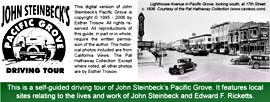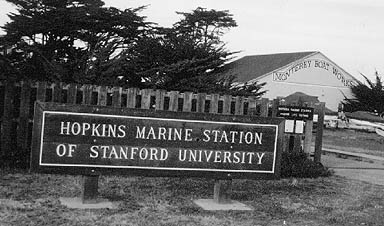|
||||||||||||
 |
||||||||||||
|
||||||||||||
|
||||||||||||
|
|
||||||||||||
 |
This tour is also available in a
pdf version. Click here
to open it. If you need to download Adobe Reader to open the pdf version, click on the logo.  |
|||||||||||
|
Google Map of Hopkins Marine Station |
||||||||||||

|
|
||||
|
Originally established at Lovers Point in 1892, moved in 1917 to China Point (now called Cabrillo Point), it was the first marine laboratory on the Pacific Coast. Associated with Stanford University, it specializes in the study of intertidal life. Steinbeck and his younger sister, Mary, played here as children
and later studied zoology and English here in the summer of 1923.
Their teacher, C.V. Taylor, was a disciple of the ideas of Berkeley's
William Emerson Ritter, whose concept of the super-organism influenced
Steinbeck. Dr. Walter K. Fisher (Director of Hopkins from 1917 to 1943) was an ardent critic of Ricketts' ecological approach in Between Pacific Tides and hindered prompt publication of the book. Dr. Rolf Bolin, who identified some of the specimens from The Sea of Cortez trip, was an ichthyologist associated with Hopkins. Some of Ricketts' papers were donated to Hopkins after his death in 1948. 
Click here for Hopkins' home page. |

|

|

|

|

|

|

|

|

|

|

|

|

|

|

|

|

|

|
